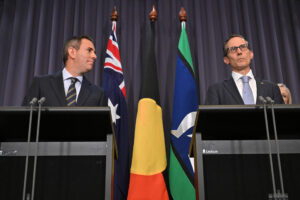Would you like a recession with that? New Zealand shows the danger of high interest rates

New Zealand’s central bank raised interest rates more than Australia and went into a recession – twice.
Recently there have been calls for the Reserve Bank to increase interest rates because inflation has remained “sticky” at 3.5%-4%. These calls are coming even though this may push Australia into recession. This horrifying scenario is being shrugged off by some as the price we have to pay to get inflation down – but the experience of New Zealand shows higher interest rates do not always bring down inflation, but they can very much lead to recessions.
The June quarter CPI is due out this week, and many economists predict that it will increase slightly from the current 3.6%. This comes after consistent falls in the rate of inflation since the end of 2022. In fact, the inflation rate has fallen from 7.8% in December 2022 to 3.6% in March 2024.
But a more than halving in the inflation rate is not enough for the armchair inflation hawks who are determined to see the inflation rate back into the Reserve Bank’s target band as soon as possible and regardless of the cost.
The idea that the costs of slightly elevated inflation are in any way comparable to the costs of a recession is just ridiculous. Recessions cause widespread suffering, unemployment, and economic scaring that can last for a decade or more.
Now that wages are growing faster than inflation, the costs of inflation are minimal, particularly when it is less than a percentage point above the target band.
Even worse, higher interest rates are unlikely to bring inflation down any faster.
Normally inflation is caused when the economy is booming, incomes and spending is rapidly rising, and businesses can’t keep up with all the additional demand. In this situation, higher interest rates act by reducing spending and slowing the booming economy.
The inflation Australia and the rest of the world are facing is not that kind of inflation. It is a much more uncommon kind of inflation that is caused by supply shocks. Supply shocks increase the costs that businesses face which leads to increased prices. Importantly higher costs can’t be fixed by increasing interest rates, making them a far less effective policy response.
As former governor Philip Lowe pointed out, there is very little that monetary policy can do to offset supply shocks, and you should “let the supply shock wash through the system.”
New Zealand is a case in point. It has increased its official interest rate faster and higher than Australia. While Australia’s cash rate is at 4.35%, New Zealand’s rate is at 5.5%.
The New Zealand economy has been dipping in and out of technical recession for 18 months. A technical recession is two consecutive quarter of negative economic growth – and New Zealand has experience that twice.
By comparison Australia’s, economic growth has slowed but it has continued to remain positive.
The problem for New Zealand is that the higher interest rates and slower economic growth have not led to a faster drop in inflation. If we compare the inflation in New Zealand and Australia, we can see that while inflation in New Zealand took off earlier than in Australia, both countries are seeing inflation come down at about the same pace.
This should be a warning to the Reserve Bank that higher interest rates might work to crash the economy, pushing up unemployment, and heaping more misery on Australian households, but they will do little to bring down prices.
Inflation is already on its way down as the supply shocks that set off this bout of inflation resolve themselves. When the June quarter inflation rate comes out, it might show the path back to the target band is not completely smooth. It may even increase slightly. But this is a time when the Reserve Bank needs to show courage and ignore the armchair critics and keep interest rates on hold.
Inflation is coming down and a recession would be the worst possible outcome.
Related research
You might also like
Australia dumps its care crisis on the Pacific – new report
Skilled health workers from Pacific Island countries are being poached to plug Australia’s shortage of care workers, leaving the health systems in their home countries on the brink of collapse, according to new research.
Want to lift workers’ productivity? Let’s start with their bosses
Business representatives sit down today with government and others to talk about productivity. Who, according to those business representatives, will need to change the way they do things?
Australia does not have a “productivity crisis” – new research
New research by The Australia Institute reveals there is little evidence of a “productivity crisis” in Australia, despite claims to the contrary from business leaders and politicians.



